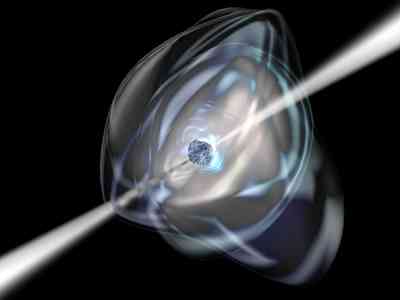Michal Levinstein

Like wobbly monsters in zombie (living dead) horror movies, the corpses of dead stars may nevertheless contain some warlike prowess within.
ESA's Integral spacecraft analysis of a number of anomalous X-ray pulsars, which are considered neutron stars with very strong X-ray beams that regularly pass by Earth. It was discovered that these stars have magnetic fields that are billions of times stronger than any magnetic field created on Earth.
The 'stellar corpses' were surprisingly found to emit extremely powerful X-ray and gamma-ray bursts. This discovery links these objects to the strongest active magnetic bodies in the universe. Scientists will now have to reexamine how dead stars really behave.
Known as Anomalous X-ray Pulsars (AXPs), the corpses of stars were first discovered in the 70s as low-energy X-rays launched into space (by the Uhuru X-ray Satellite). AXPs are very rare - only 7 of them have been discovered. The X-rays were thought to be produced by material falling from a companion star to the AXP star.
Another alternative was that AXP is the core of a dead star - known as a neutron star - that throws beams of energy into space like a cosmic beacon. As these beams pass the Earth - the AXP appears to turn on and off. This scenario requires the AXP's magnetic field to be a billion times stronger than any stable magnetic field produced under laboratory conditions on Earth. And the observations show that it is indeed so.
The newly discovered emission from such an object - called by the astronomers 'Hard Tail' (of X and gamma rays) comes in the form of pulses every 6-12 seconds (depending on the location of the AXP). In 3 out of 4 such objects studied - the 'Hard Tail' has a distinct energetic signature, which forces the scientists to conclude that it was created from super-strong magnetic fields. This energy is 10-1,000 times stronger than what would be expected from the friction of a rotating AXP with the space around it. The scientists are consequently left with a "degenerate magnetic field" theory.
Neutron stars with super-strong magnetic fields are called Magnetars. They are formed from the core of a giant star that exploded at the end of its life. Their diameter is only around 15 km - but only about one and a half solar masses.
Magnetars are also responsible for 'Soft Gamma-ray Repeaters' (SGRs), when they release massive amounts of energy as a result of catastrophic explosions that occur in them during spontaneous reorganization of the magnetic field. The big difference between SGR and AXP is that in AXP the process is continuous and less energetic.
"Somehow these objects drain the huge amounts of energy below their surface and channel them into space" say the scientists. How exactly the process is done is a subject for future research. It may be that SGRs - of which 5 are known - become AXPs after they consume large amounts of energy in explosions into space.
All but one of the known AXPs are clustered toward the plane of our galaxy—suggesting that they are the result of recent star explosions. The other is within a satellite galaxy of the Milky Way.
Michal's website (within the Astronomy Association website
